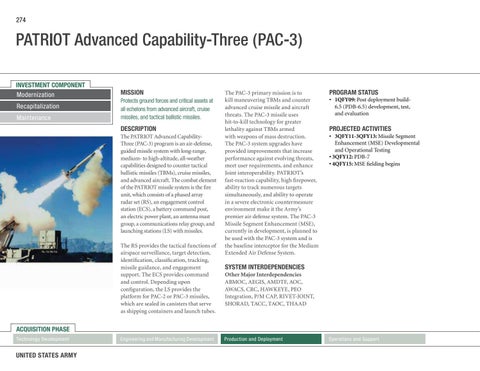274
PATRIOT Advanced Capability-Three (PAC-3) INVESTMENT COMPONENT Modernization
MISSION
Recapitalization
Protects ground forces and critical assets at all echelons from advanced aircraft, cruise missiles, and tactical ballistic missiles.
Maintenance
DESCRIPTION The PATRIOT Advanced CapabilityThree (PAC-3) program is an air-defense, guided missile system with long-range, medium- to high-altitude, all-weather capabilities designed to counter tactical ballistic missiles (TBMs), cruise missiles, and advanced aircraft. The combat element of the PATRIOT missile system is the fire unit, which consists of a phased array radar set (RS), an engagement control station (ECS), a battery command post, an electric power plant, an antenna mast group, a communications relay group, and launching stations (LS) with missiles. The RS provides the tactical functions of airspace surveillance, target detection, identification, classification, tracking, missile guidance, and engagement support. The ECS provides command and control. Depending upon configuration, the LS provides the platform for PAC-2 or PAC-3 missiles, which are sealed in canisters that serve as shipping containers and launch tubes.
The PAC-3 primary mission is to kill maneuvering TBMs and counter advanced cruise missile and aircraft threats. The PAC-3 missile uses hit-to-kill technology for greater lethality against TBMs armed with weapons of mass destruction. The PAC-3 system upgrades have provided improvements that increase performance against evolving threats, meet user requirements, and enhance Joint interoperability. PATRIOT’s fast-reaction capability, high firepower, ability to track numerous targets simultaneously, and ability to operate in a severe electronic countermeasure environment make it the Army’s premier air defense system. The PAC-3 Missile Segment Enhancement (MSE), currently in development, is planned to be used with the PAC-3 system and is the baseline interceptor for the Medium Extended Air Defense System.
PROGRAM STATUS • 1QFY09: Post deployment build6.5 (PDB-6.5) development, test, and evaluation
PROJECTED ACTIVITIES • 3QFY11-3QFY13: Missile Segment Enhancement (MSE) Developmental and Operational Testing • 3QFY12: PDB-7 • 4QFY15: MSE fielding begins
SYSTEM INTERDEPENDENCIES Other Major Interdependencies ABMOC, AEGIS, AMDTF, AOC, AWACS, CRC, HAWKEYE, PEO Integration, P/M CAP, RIVET-JOINT, SHORAD, TACC, TAOC, THAAD
ACQUISITION PHASE Technology Development
UNITED STATES ARMY
Engineering and Manufacturing Development
Production and Deployment
Operations and Support



















































